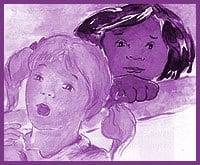As a queer student teacher, I am often required to teach a curriculum that does not reflect my experience. So I was pleased when James Chamberlain launched a legal challenge against the school board in Surrey, BC, a challenge he won at the Supreme Court Of Canada last December. That decision will help move queer issues into the pantheon of multiculturalism.
Citing the religious beliefs of some parents, the Surrey board had refused to approve as teaching materials three books depicting families headed by same-sex parents. Chamberlain was prevented from using these books to teach family life education to kindergarten and grade one students.
The court’s decision made some excellent points that will likely influence school boards throughout the country when making choices about the inclusion of queer positive teaching materials in elementary schools.
For one thing, the court refused to allow the rights and interests of parents expressing religious opposition to homosexuality to trump those of same-sex parents and their children. Instead, the court found a way to balance these diverging rights and interests: Parents are free to educate their kids in accordance with their own views, but in a secular, public system of education, it is essential that no one set of values be permitted to predominate.
So, the court says, schools should not allow “any attempt to use the religious views of one part of the community to exclude from consideration the values of other members of the community.” It’s promising the court was not fooled by homophobia couched in the rhetoric of religious freedom.
The court also rejected the argument that children of opposite-sex parents will experience “cognitive dissonance,” a term used to connote the distress that results from encountering two opposing ideas – like learning about the existence of families headed by same-sex parents. The court specifically rejected the argument that children from religiously opposed families will be “confused” by the destigmatizing images of queer families offered in the texts.
As a teacher candidate, it never ceases to amaze me how quickly adults are to project their own prejudices onto children. Young children, from my experience, are remarkably accepting. They are willing and able to respect social diversity, while maintaining a strong sense of their own identity.
Educators have been making sincere efforts to cultivate children’s respect and understanding of racial and cultural diversity, but queerness is seldom considereda culture and isn’t usually included under the rubric of multiculturalism.
The court’s implicit analogy between queerness and other racial or religious minorities will hopefully change that. Queerness has all the elements of our conventional definition of culture. Queers have our own norms, values, festivals and even an annual holiday. Like any other aspect of cultural difference, the decision considers it perfectly reasonable to allow, even require, schools to discuss the diversity of families.
Though it is easy to see why this decision is a victory for queer and queer-positive educators, same-sex parents and their children, the decision is still limited. For one thing, the Supreme Court doesn’t in the end do what Chamberlain was really asking it to do: order the Surrey board to approve the books. (Right after winning his case, Chamberlain launched another case to do that – force schools to include information about same-sex families in parts of the curriculum dedicated to multicultural studies.)
Instead, the Supreme Court ordered the board to reconsider its original decision in light of the principles articulated by the court. The possibility remains that the board will reject the books again, this time for an ostensibly pedagogical reason. And whether these texts actually get taught in classrooms after their approval remains at the discretion of individual teachers.
Another limit is that decision only deals with three books related to one subject area in two grades. What is beyond the scope of this decision is the issue of sexual education in primary and junior grades and its treatment of homosexuality and same-sex relationships. Particularly troubling, to me, is the state of Ontario’s health and sexual education curriculum. Right now, only heterosexual forms of sexuality are presented to elementary school-aged children, reinforcing heterosexist stereotypes. It remains to be seen how comfortable the court is with education about queer sex or sexuality, especially within primary classrooms. After all, these particular books – Asha’s Mums, Belinda’s Bouquet and One Dad, Two Dads, Brown Dads, Blue Dads – offer a glimpse into gay and lesbian family life that is free of sex or even indications of sexuality, unlike the realities of our lives.
It is clear to me that we still have a long way to go to bring about a truly anti-heterosexist and anti-homophobic curriculum. The exclusion of queer history, geography, statistics, arts, culture, heroes and heroines from the educational experiences of children and youth signal the heterosexist nature of our public schools. While Chamberlain’s victory isn’t a panacea for all this, I believe it does have the potential to galvanize a movement toward the equal inclusion of all students, parents and teachers within our schools.

 Why you can trust Xtra
Why you can trust Xtra


